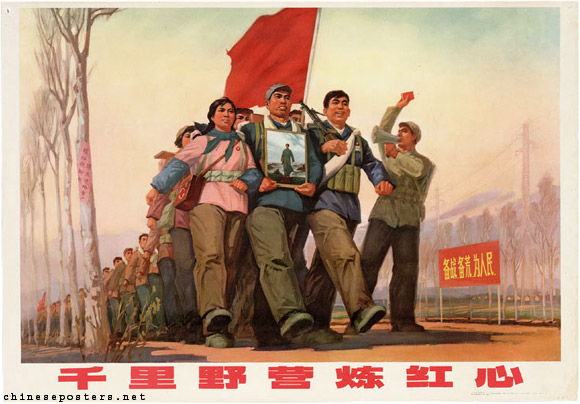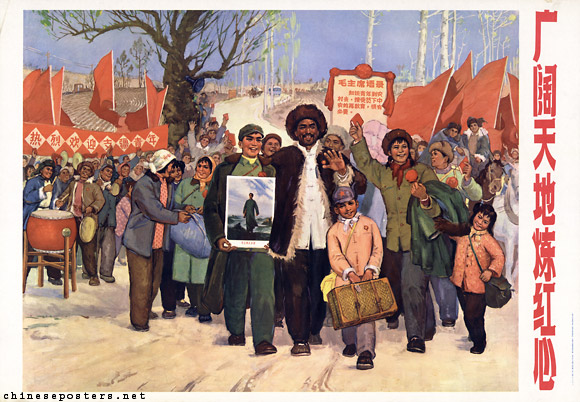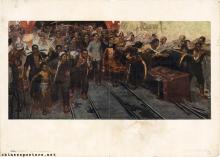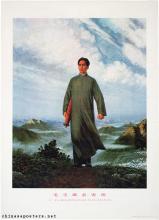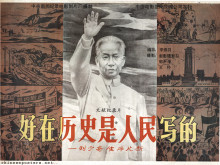Liu Chunhua, Chairman Mao goes to Anyuan, 1968
The painting-turned-poster Mao zhuxi qu Anyuan [毛主席去安源, Chairman Mao goes to Anyuan] became a cause celèbre, "... perhaps the most important painting of the Cultural Revolution period". It depicts Mao as a young man on his way to the city of Anyuan to lead a miners’ strike. The work was explicitly promoted by Jiang Qing as a model painting equal to the model operas and ballets she espoused. As such it became the benchmark for the iconographical representation of Mao. The painting was made by Liu Chunhua, a Red Guard studying at the Central Academy of Industrial Arts, but it was collectively designed and planned by a group of students from universities and institutes in Peking. Liu explained how the painting was preconceived along ideological lines and invested with symbolic meaning:
"To put him in a focal position, we placed Chairman Mao in the forefront of the painting, advancing towards us like a rising sun bringing hope to the people. Every line of the Chairman’s figure embodies the great thought of Mao Zedong and in portraying his journey we strove to give significance to every small detail. His head held high in the act of surveying the scene before him conveys his revolutionary spirit, dauntless before danger and violence and courageous in struggle and in ‘daring to win’; his clenched fist depicts his revolutionary will, scorning all sacrifice, his determination to surmount every difficulty to emancipate China and mankind and it shows his confidence in victory. The old umbrella under his right arm demonstrates his hard-working style of travelling, in all weather over great distances, across the mountains and rivers, for the revolutionary cause [...] The hair grown long in a very busy life is blown by the autumn wind. His long plain gown, fluttering in the wind, is a harbinger of the approaching revolutionary storm [...] With the arrival of our great leader, blue skies appear over Anyuan. The hills, sky, trees and clouds are the means used artistically to evoke a grand image of the red sun in our hearts. Riotous clouds are drifting swiftly past. They indicate that Chairman Mao is arriving in Anyuan at a critical point of sharp class struggle and show, in contrast how tranquil, confident and firm Chairman Mao is at that moment [...]."
To go on a thousand ‘li’ march to temper a red heart, 1971
It is believed that more than nine hundred million copies of the painting were eventually printed. It was displayed at meetings and carried around during demonstrations, mass meetings and processions, and many found their way onto walls, next to the official portrait of the Chairman. Another indication of the importance of this painting and its message is provided by fact that it was meticulously reproduced on a number of posters, thus spreading its message even further. The painting was meant to discredit Liu Shaoqi, who had played a much more important role in organizing the labor movement in Anyuan in the 1920s than Mao.
Melissa Chiu, Zheng Shengtian, Art and China’s Cultural Revolution (New York: Asia Society, Yale University Press, 2008)
"Great and Noble Image", Chinese Literature 1968, n. 9, pp. 41-47
Liu Chunhua, "Painting Pictures of Chairman Mao is our greatest happiness", China Reconstructs, October 1968, pp. 2-6
Liu Chunhua, "Singing the Praises of Our Great Leader is Our Greatest Happiness", Chinese Literature, 1968, n. 9, pp. 32-40
"A Splendid Revolutionary Oil Painting", China Pictorial 1968 n. 9, pp. 12-13
Yang Kelin (ed.), 文化大革命博物馆 [Museum of the Cultural Revolution] (Hong Kong: Dongfang chubanshe youxian gongsi, Tiandi tushu youxian gongsi 1995)
Zheng Shengtian, "Chairman Mao Goes to Anyuan. A Conversation with the Artist Liu Chunhua", in: Melissa Chiu, Zheng Shengtian, Art and China’s Cultural Revolution (New York: Asia Society, Yale University Press, 2008), pp. 118-132

